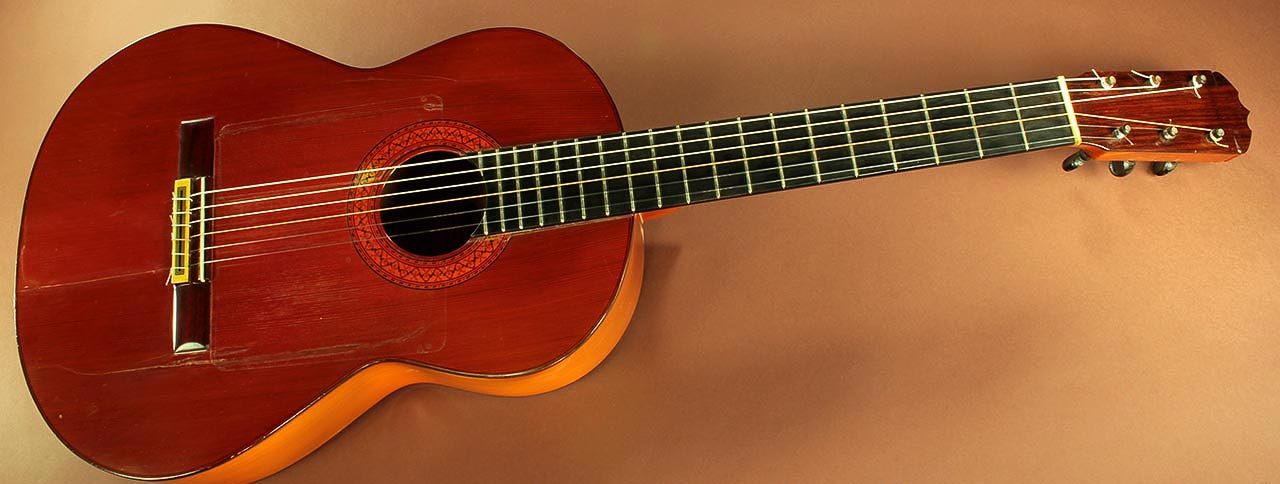Welcome to one of the most active flamenco sites on the Internet. Guests can read most posts but if you want to participate click here to register.
This site is dedicated to the memory of Paco de Lucía, Ron Mitchell, Guy Williams, Linda Elvira, Philip John Lee, Craig Eros, Ben Woods, David Serva and Tom Blackshear who went ahead of us.
We receive 12,200 visitors a month from 200 countries and 1.7 million page impressions a year. To advertise on this site please contact us.
|

|
|
Ramirez 2A
|
You are logged in as Guest
|
|
Users viewing this topic: none
|
|
Login  | |
|

 
C. Vega
Posts: 379
Joined: Jan. 16 2004

|
 RE: Ramirez 2A (in reply to Michael1917) RE: Ramirez 2A (in reply to Michael1917)
|
|
|
That sure is a helluva lot of story for one used guitar on that 12th Fret website!
At the time this particular guitar was made the only real difference between the 1a and 2a models was the use of some wood that didn't quite meet Jose III's lofty cosmetic standards for use in a first class instrument. In this case my guess would be the dark resin streak on the back being the reason for the 2a designation. The 2a models sold for a bit less money when they were new. Structurally, both models are identical.
The Ramirez III signature really doesn't count for much. From about mid-1967 onwards, every guitar made in the Ramirez shop received the boss's signature....Jose III, Jose IV and, currently. Amalia Ramirez...but in nearly every case they were actually made by other workers. Jose IV was perhaps the most hands-on luthier of the three. Jose III most likely didn't make any guitars himself after the 1950s. Amalia has apparently made a few and she seems to like posing for photos and videos in the workshop but her primary focus has always been the commercial and administrative aspects of the business.
By the time this guitar was made they had stopped using the initials stamped on the foot inside the guitar that identified the primary assembler of a particular guitar but this one may have a number stamped on the underside of the top below the fingerboard indentifying the assembler. I'm not sure when they stopped using the numbers. These names, initials and numbers are listed on the Ramirez website.
Contrary to what some believe, or would have you believe, Ramirez guitars (regardless of stamped initials, numbers, etc.) were not and are not made from start to finish by a single worker. There were and are a number of pairs of hands involved.
Prior to 1967 there were no actual model designations and the labels did not have the extended section with the signature and serial number but from about 1957 and into the mid-1960s the Ramirez shop made what was more or less the equivalent of a 2a model. These guitars also utilized wood that was considered to be somewhat less than cosmetically ideal but still properly cut and well seasoned. They can be identified by a label that has a gold border and the initial letters of the label text, but not the Ramirez name, printed in red.
They were sometimes assembled under the supervision of senior oficiales by workers who were about to be granted full artisan status by Ramirez and sometimes by the senior workers themselves.
The Madrid luthier Felix Manzanero, who was working for Ramirez at that time, told me that if one of these guitars has no initial stamp on the foot it was probably made by one of the up-and-comers but any initialed guitar would have been made by a fully qualified oficial. Only workers with full artisan status were allowed to stamp their initials in the guitars.
Felix also said that the flamenco guitars with the gold-bordered labels were usually purchased by the real working pros.... the guys who played the clubs, tablaos and penas on a regular basis. Most of them weren't particularly concerned with minor cosmetic blemishes in the wood. They were more interested in sound and playability...as well as in saving a few pesetas. I think that this is one of the reasons that when you do encounter these guitars they often look like (continuing the 12th Fret's equine analogy) they've been ridden hard and put away wet as opposed to the pristine collector's case queen primera models that sometimes come up for sale.
FWIW, in the forty-odd years I've been fooling around with this stuff I've only encountered perhaps two or three Ramirez classical models with a gold-bordered label but I have personally seen well over a dozen flamencos plus photos of and references to numerous other examples.
|
|
|
|
REPORT THIS POST AS INAPPROPRIATE |
Date Jan. 4 2013 2:01:52
 |
|
 New Messages New Messages |
 No New Messages No New Messages |
 Hot Topic w/ New Messages Hot Topic w/ New Messages |
 Hot Topic w/o New Messages Hot Topic w/o New Messages |
 Locked w/ New Messages Locked w/ New Messages |
 Locked w/o New Messages Locked w/o New Messages |
|
 Post New Thread
Post New Thread
 Reply to Message
Reply to Message
 Post New Poll
Post New Poll
 Submit Vote
Submit Vote
 Delete My Own Post
Delete My Own Post
 Delete My Own Thread
Delete My Own Thread
 Rate Posts
Rate Posts
|
|
|
Forum Software powered by ASP Playground Advanced Edition 2.0.5
Copyright © 2000 - 2003 ASPPlayground.NET |
0.046875 secs.
|


 Printable Version
Printable Version






 New Messages
New Messages No New Messages
No New Messages Hot Topic w/ New Messages
Hot Topic w/ New Messages Hot Topic w/o New Messages
Hot Topic w/o New Messages Locked w/ New Messages
Locked w/ New Messages Locked w/o New Messages
Locked w/o New Messages Post New Thread
Post New Thread